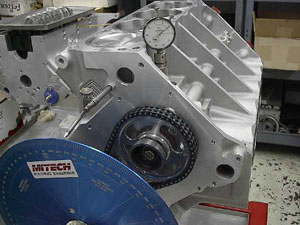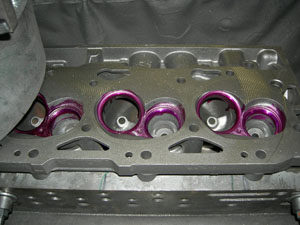
Engine Blueprinting By Eddies Performance
Engine blueprinting is a standard procedure utilized at Eddies Performance machine shop. We feel Blueprinting your engine is completely nessassary to obtain maximum power and to insure the longest possible engine life and reliability. It also adds discipline to our process which decreases any chance of engine failure due to improper clearances.
When we proceed with an engine build we always execute the entire engine blueprinting process. This means hand building an engine with perfectly fit components using maximum and minimum recommended clearances. These specifications are determined using our 35 years of engine building experience.

How Eddies Performs The Engine Blueprint Process
First, we make sure all parts are one hundred percent clean. This is done by boiling the block, making certain water jackets are perfectly clean. We also inspect and analyze the block (especially if it's used) bolt holes would be re-tapped, cleaned and oiled, as well as their mating bolts. Any surfaces we refinish will have all holes chamfered, and any casting burrs or irregularities will be ground away.
The V type block will be align bored to maintain perfectly equal deck heights and keeping the crankshaft parallel to the decks. Any variation in these areas will result in irregularities in combustion chamber volume. This is critical in our accurate and precision blueprinting process.
After align boring, cylinders are bored with the main bearing caps still torqued in place. We then finish hone the cylinders to their proper size using a 220-280 grit stone and taking care to obtain a good cross hatch pattern. After honing the block we boil it again, taking care to remove all honing grit from the bores and also from the lower end of the block.
The crankshaft must have correct angularity of the rod throws as well as be perfectly straight. If your block is used we check it for cracks and have the journals ground to perfect angular index. Oil holes get chamfered and bearing surfaces polished. The oil passages are then cleaned thoroughly with a good brush. We use fully grooved main bearings or groove or cross drill the crankshaft main bearing journals. These procedures are also helpful in insuring longer engine life.
If used the connecting rods will be carefully checked for imperfections and Magnafluxed. All rods are reworked so they are EXACTLY the same length from crankshaft centerline to wrist pin centerline. Generally the length of the rods will be controlled by working to the minimum manufacturer's clearance for piston to deck. Any burrs and irregularities will be removed from the rods, and always use new rod bolts and nuts. The rod alignment and side clearance are also critical.
The pistons should be individually and carefully fit to the respective pins. Chamfering any sharp edges on the piston reduces possibility of localized hot spots which cause pre-ignition and/or detonation. Each piston is carefully matched for clearance with each bore. Too little clearance will result in scuffing and too much clearance reduces the effectiveness of the rings.
The compression rings should each be placed in the bore and straightened with the top of a piston to square the ring in the bore. Gaps can then be checked, with .0035 per inch of bore the minimum allowable gap. We are also sure to check ring side clearance in piston groove. The maximum is .006 but .003-.004 is most desirable.
Now that the main reciprocating components are selected and fit, the engine roatating assemblies be balanced. We continue balancing with rings, pistons, rods, bearings, crankshaft, flywheel, crankshaft dampner and pulley. Some engines recommend an allowance for oil weight in the crankshaft when balancing. Additional weight is added to the bob weights in these cases to compensate for oil weight. Balancing will provide insurance for engine durability, and will also help obtain maximum horse-power.
The cylinder head is disassembled, cleaned and carefully inspected for cracks. If the surface is in questionable condition we go ahead and resurface it. All holes and sharp edges should be carefully chamferred and deburred. Bolt and spark plug holes get retapped and cleaned. The valve guides are checked and replaced or repaired as necessary.
We also check valve stems and replace those valves not acceptable. This is also the time we machine the valve guides if necessary for the installation of seals. The valve job should be done according to recommendations for the engine. Click here to read the entire valve grinding process.
All burrs and irregularities should be polished out of the combustion chamber. After this the chambers should be checked for volume in cubic centimeters. The chambers are then enlarged by grinding to the volume of the largest chamber. When all chambers are equalized the desired minimum CC's we can mill the heads carefully until the correct volume is reached.

In order to check the CC volume of the chamber a Plexiglas plate, light oil, and a chemical burette are needed. With the spark plug and valves installed the plate is placed over the combustion chamber and sealed with a light coat of lubricant. Using the burette it is then a simple matter to measure the amount of liquid needed to fill the combustion chamber.
Valve springs are checked for tension and installed height, and replaced or shimmed as needed. If the head has individual rocker arms on studs the stud should be threaded or pinned in its boss.
The next step is to torque main bearing and rod bolts slowly and in progressive steps to the proper tension. We use protectors on the rod bolts to prevent crankshaft scars, and keep rotating the engine as each step in the installation of the crankshaft and pistons is taken. This will enable spotting the exact location of any misfit or mismatched parts.The use of Plastigage here will serve as a double check on clearances.
We then install the timing gears and chain the use of a camshaft degree wheel will insure perfect crankshaft to camshaft timing.
Offset keys or cam gear bushings are available to allow accurate adjustment of possible timing discrepancies.
After installing the heads, we make sure they are torqued to the proper specifications, the valve train will then be completed and checked. In cases where higher lift camshafts have been installed it is possible to have the valve spring bottom out, or the canoe type rocker be interfered with by its mounting stud. Where this happens the spring must be changed, and the rocker arm relieved to provide the necessary clearance.
The complete engine build we go throught at Eddies Performance must be performed as painstakingly and accurately as possible. The blueprinted engine is the utmost in performance, horsepower and durability possible, and its success is a real testimony to the expertise of the years of experience at Eddies Performance.
Quality Control With Your Engine Is Our #1 Priority
At Eddies Performance quality control is an important factor in our customer experience. Careful measures in checking and double checking clearances is our precedence in producing a fast, reliable engine that will bear our responsibility.
If you would like to discuss your application please give us a call on our toll free number 1-800-471-2325 from 9am to 5pm EST.
|





